The large surface area in the gut directly facilitates – The large surface area of the gut directly facilitates a myriad of physiological processes, playing a crucial role in nutrient absorption, digestion, and overall health. This extensive surface area, with its intricate folds and villi, provides an optimal environment for the efficient breakdown and uptake of nutrients, shaping the gut’s vital contribution to human well-being.
The gut’s vast surface area, estimated to be around 250 square meters, is a testament to its significance in nutrient absorption. This expansive surface maximizes contact between the gut lining and ingested nutrients, enabling efficient uptake into the bloodstream. Specific regions of the gut, such as the small intestine and colon, are specialized for the absorption of different nutrient types, ensuring optimal utilization of dietary components.
The Large Surface Area of the Gut

The gastrointestinal tract, commonly known as the gut, possesses an extensive surface area that plays a crucial role in various physiological processes. This vast surface, spanning hundreds of square meters, facilitates nutrient absorption, digestion, and other essential functions.
The large surface area of the gut is primarily due to the presence of numerous folds, villi, and microvilli lining its inner walls. These structures collectively increase the surface area, allowing for efficient contact between the gut lumen and the underlying tissues.
Role in Nutrient Absorption, The large surface area in the gut directly facilitates
The extensive surface area of the gut is vital for the efficient absorption of nutrients from ingested food. The villi and microvilli, which are finger-like projections, provide a large surface area for nutrient uptake. These projections increase the contact area between the gut lumen and the blood vessels, facilitating the absorption of nutrients into the bloodstream.
Different regions of the gut are responsible for absorbing specific types of nutrients. The small intestine, which is the longest part of the gut, is primarily responsible for absorbing carbohydrates, proteins, and fats. The large intestine, on the other hand, mainly absorbs water, electrolytes, and certain vitamins.
| Nutrient | Region of Absorption |
|---|---|
| Carbohydrates | Small intestine |
| Proteins | Small intestine |
| Fats | Small intestine |
| Water | Large intestine |
| Electrolytes | Large intestine |
| Vitamins (e.g., B12, K) | Large intestine |
Contribution to Digestion
The large surface area of the gut also contributes significantly to the mechanical and chemical breakdown of food. The villi and microvilli increase the surface area for enzymes to interact with food particles, enhancing the efficiency of digestion.
The gut secretes various digestive enzymes that break down food into smaller molecules for absorption. These enzymes include pepsin, trypsin, and chymotrypsin, which are responsible for breaking down proteins; lipases, which break down fats; and amylases, which break down carbohydrates.
The flow of food through the gut is a complex process that involves peristalsis, a series of rhythmic contractions that propel food along the digestive tract. The large surface area of the gut ensures that food is thoroughly mixed with digestive enzymes, maximizing the efficiency of digestion.
Impact on Gut Microbiota
The large surface area of the gut provides a vast habitat for a diverse community of microorganisms known as the gut microbiota. These microorganisms play a crucial role in various aspects of human health, including digestion, immune function, and metabolism.
The large surface area of the gut allows for the colonization and interaction of different microbial species. These interactions can be beneficial or harmful to human health. Beneficial microorganisms, such as probiotics, can help with digestion, produce vitamins, and protect against pathogens.
Harmful microorganisms, such as pathogenic bacteria, can cause infections and contribute to disease.
- Beneficial effects of gut microbiota:
- Aid in digestion and nutrient absorption
- Produce vitamins and other essential nutrients
- Protect against pathogens
- Regulate immune function
- Potentially harmful effects of gut microbiota:
- Cause infections
- Contribute to chronic diseases, such as inflammatory bowel disease and obesity
- Produce toxins
Implications for Health and Disease
The large surface area of the gut can contribute to the development of certain diseases. Increased gut permeability, a condition in which the gut lining becomes more permeable to substances that should not pass through, has been linked to various health issues, including food allergies, autoimmune disorders, and chronic inflammation.
Maintaining a healthy gut surface area is crucial for overall well-being. A balanced diet, regular exercise, and adequate sleep can help maintain a healthy gut lining and promote a diverse and beneficial gut microbiota. Conversely, factors such as stress, certain medications, and a diet high in processed foods can damage the gut lining and disrupt the gut microbiota, leading to health problems.
FAQ Section: The Large Surface Area In The Gut Directly Facilitates
How does the gut’s surface area contribute to nutrient absorption?
The large surface area of the gut, with its folds and villi, increases the contact surface between the gut lining and nutrients, facilitating efficient absorption into the bloodstream.
What is the role of the gut’s surface area in digestion?
The increased surface area aids in the mechanical breakdown of food through peristalsis and provides an optimal environment for digestive enzymes to break down complex molecules into absorbable components.
How does the gut’s surface area influence the gut microbiota?
The large surface area provides a diverse habitat for microbial colonization, supporting a complex ecosystem that plays a crucial role in nutrient metabolism, immune function, and overall health.

